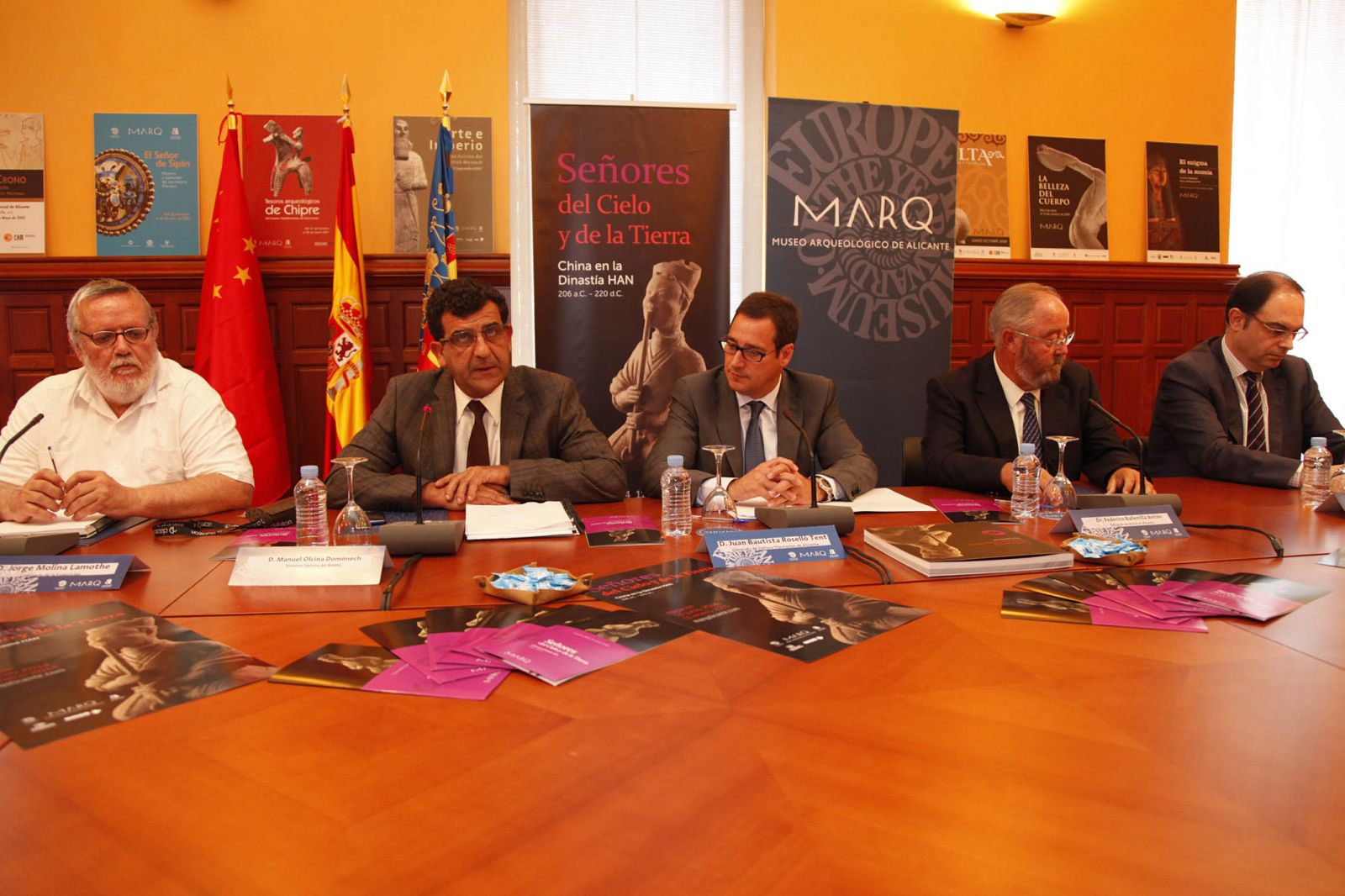
Twenty-three years ago centuries,China lived a prosperous period that lasted for almost 400 years and turned the country into a one of the greatest empires of its timeNow, the Archaeological Museum of Alicante recover through a new exhibition the story,customs and secrets of this crucial dynastic period in the history of the country, which was characterised by great political influence, economic flourishing and cultural development. A total of 256 pieces,many of them unpublishedfrom various private collections make up this exhibition, which will remain at MARQ. until next January.
The Member of Parliament for Culture Juan Bautista Roselló presented the international exhibition "Lords of Heaven and Earth. China in the Han Dynasty (206 B.C. - 220 B.C.)"which is sponsored by ASISA and the Cajamurcia Foundation. opens today, Friday 13 June with the presence of the Ambassador of the People's Republic of China in Spain Zhu Bangzhao. The event was also attended by the technical director of the museum Manuel Olcinathe ASISA delegate in Alicante Federico Ballenillathe managing director of the Cajamurcia Foundation Pascual Martínez and the curator of the exhibition Jorge Molina.
We are proud to be able to house in our rooms this valuable collection that reflects the essence and splendour of a civilisation that seems so distant, yet is present in our daily lives through inventions such as the crank, paper and the wheelbarrow.said the deputy. He added that This ability to innovate and progress is what made the Han dynasty a crucial period in the future, not only of China, but also of the rest of the world. A period that our Eurocentric upbringing has unconsciously led us to unconsciously leave in the background, but which is now regaining the prominence it deserves..
The collection is structured in four blocks that guide the visitor through an interesting journey through time. The tour begins with a didactic section containing information on the chronology,the political structure and geographic extent of this civilisation. The space also includes an audio-visual presentation explaining the evolution and significance of the Chinese writing -considered not only as a vehicle of communication but also as an artistic representation-, with emphasis on its five styles: jia-gu-wen (on tortoise shell), jin-wen (on stone), zhuan (official Han-era scripture), li (official Han-era italics) and kai (modern writing).
Progressing through the content of the exhibition, the viewer is introduced to Han's intangible culture through funerary objects relating to spirituality, philosophy, music, dance, poetry and mythology. In this block Lords of Heaven The following stand out, among others, a funeral shroud scenography more than one and a half metres long, made of hundreds of pieces of jade held together with copper wire, a zoomorphic lamp unique in its manufacture,miscellaneous polychrome terracotta vessels (cocoons) that are reminiscent of silk cocoons or various terracotta sculptures of musicians and dancers.
The following section, Lords of the Earth', refers to everyday life, the social and military structure, the relevance of horses or the female world through objects recovered from tombs such as swords, arrowheads, spears, decorated bronze handles, vessels, granary vessels, candlesticks or heads of figures made from moulds and finished by hand.
The birth of new trade routesthe development of major public worksthe progress in agricultural productionthe tax reforms or the large scientific and technological achievements of the Han dynasty are some of the aspects covered in the final section, which includes references to revolutionary inventions such as the hand crank -the most outstanding discovery of the time, the role, the wheelbarrow -whose first graphic reference in the West dates back to the 13th century, the compass -another of the great contributions to world civilisation, the seismograph, the parachute or suspension bridge.
The curator of the exhibition referred to the importance of this exhibition and pointed out that the study of China has allowed society to learn several things about the country. On the one hand, The Han dynasty established the modern state administration, a fundamental fact that made it possible to efficiently manage a territory as large and populated as China. The Han dynasty established the administration of the modern state, a fundamental fact that made it possible to efficiently manage such a large and populated territory as China..
The exhibition is based on the development of the playful-educational aspect and presents various resources that make it easier for people with disabilities to understand. In this regard, it includes information panels in Braille, plastic reliefs accessible to the touch and audiovisuals translated into sign language. The exhibition, which will be open to the public from Saturday 14 June, will be completed with 23 audiovisual that contextualise and expand on the information.
The sponsors ASISA and Cajamurcia highlighted the high standard of this exhibition and confirmed their intention to continue collaborating with MARQ on future projects. Ballenilla highlighted the link between culture and health, while Martínez emphasised the importance of this collection which delves into the history of a country as interesting as China.
Finally, Roselló recalled that Her Majesty Queen Sofía has agreed to chair the Honorary Committee of the exhibition and pointed out that from the provincial institution we would like to thank him for this important gesture and highlight the interest he has always shown towards the province, in general, and towards this museum in particular..
